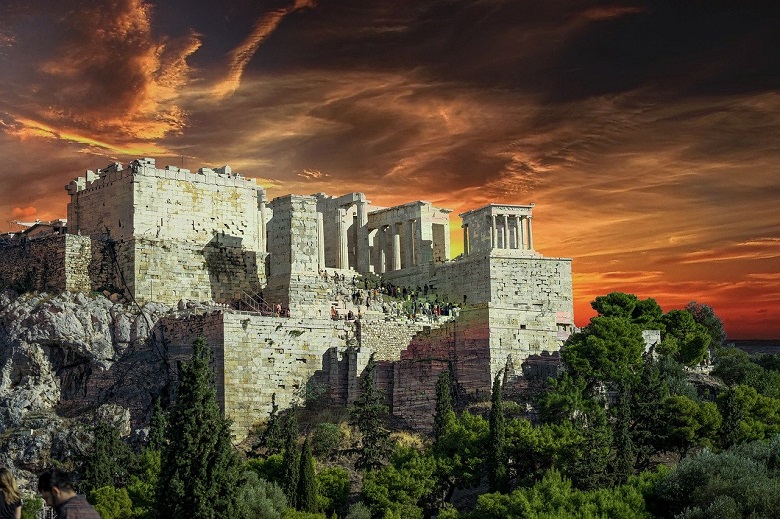In the distant past, humanity has undergone many changes: we got rid of abundant hair, traveled horses, and wiped out some entire civilizations from the face of the Earth.
Minoan civilization
The Aegean civilization of the Bronze Age lived on the island of Crete in the years 3000-1450B.C. The society got its name thanks to the mythical king Fr. Crete – Minos. According to legend, he owned a labyrinth, which was built by the famous artist Daedalus. Archaeologist Arthur Evans discovered the Minoan civilization at the end of the 19th century.
The main activity of the Minoans associated with navigation: they were engaged in trade, piracy and were friends with ancient Egypt. The cultural centers of civilization were the so-called palaces – political and economic buildings that did not have any fortifications. The Minoans felt entirely secure on their island.
The disappearance of the Minoan civilization began with the raids of the Achaean Greeks. Then, due to the mixing of cultures, a new one appeared – the Mycean. She began to actively develop on the mainland of Greece, the islands of the Aegean Sea, and in eastern Middle-earth. The Minoan civilization completely disappeared after the Dorian invasion in the VI-III centuries B.C.
2. Olmec civilization
The Olmecs are one of the first major civilizations in Mexico. They lived in tropical jungles in the southern and central parts. Today there are two states there: Tabasco and Veracruz. It believes that the Olmecs were the bearers of the Mixe-Zoquean languages .
Civilization flourished during the Mesoamerican period (1500 – 400 BC). The Olmecs laid the main direction for the following cultures of South America. They became the first civilization to practice sacrifices, bloody rituals and invented the ball game.
The Olmec civilization discovers at the turn of the 19th and 20th centuries: collectors of antiquities saw unusual items of the pre-Columbian era on the market. Now all over the world, the Olmecs are recognized by the statues of giant heads. The disappearance of the Olmecs is associated with the inability to farm and the constant eruption of volcanoes.
3. The Phoenician civilization
It is on the east coast of the Mediterranean Sea. It was the most powerful civilization of the ancient world with developed maritime trade, crafts, and culture. The writing of Phenicia is the first recorded in the history of the phonetic writing system. The flourishing of civilization fell from 1200-800. B.C.
The Phoenician civilization gradually disappeared. It all began in the 8th century BC. from the capture of Phenicia by the Assyrian kingdom. The Phoenicians were ready to pay tribute as long as they did not interfere with trading activities. Through the II century, Phenicia passed to the Persians, gained independence, and united with Carthage
In the next few centuries, Phenicia underwent several conquests: Alexander the Great, Tigranes the Great, the Roman Empire. By the 1st century BC., the Phoenician civilization dissolved.
4. Nabataean Kingdom
The Nabataean Kingdom is a Semitic Nabatean tribe that existed from the 3rd century BC. to 106 A.D. Nabataeans took over the areas of Jordan, Syria, Israel, and Saudi Arabia. The heart of the kingdom was the town of Petra in the Wadi Musa Valley.
The Nabataeans consider an Arab tribe, although they used the Aramaic script. Now the Nabatean writing is the basis that formed the classical Arabic script.
Because of its territory, Nabatea was the object of rivalry between Egypt and Seleucid, interested in trade with Arabia. The path to the latter lay through the Nabatean territory. Therefore, constant forays into Petra were the norm for Nabatea.
From the beginning first century B.C. to the 1st century AD, Rome was actively conquering territory. Then Nabatea retained its independence and allied with the Romans. In 105, after the death of the king of Nabatea Rabbel II, from the ancient kingdom, it turned into the Roman province of Arabia Petreia.
5. Moche Civilization
Moche lived on the coast of Peru in the 1st – 8th centuries. They occupied 11 valleys in the northern arid coastal Peru. Moche invented a complex irrigation system of canals, fertilized the land with droppings, and cultivated crops: corn and beans.
The ancient Peruvian civilization was good artisans. They had a highly developed processing of metals: gold, silver, copper. They have developed several ways to create copper alloys. The Moche civilization compares to the Bronze Age of Europe.
Despite all their development, the Moche still actively practiced human sacrifice. It believes that it was rituals that led to the disappearance of civilization. Moche invested enormous energy and resources in bloody ceremonies. During the excavations, it was found that most of the victims were young people. Therefore, Moche probably wiped themselves off the face of the Earth with their own hands.
